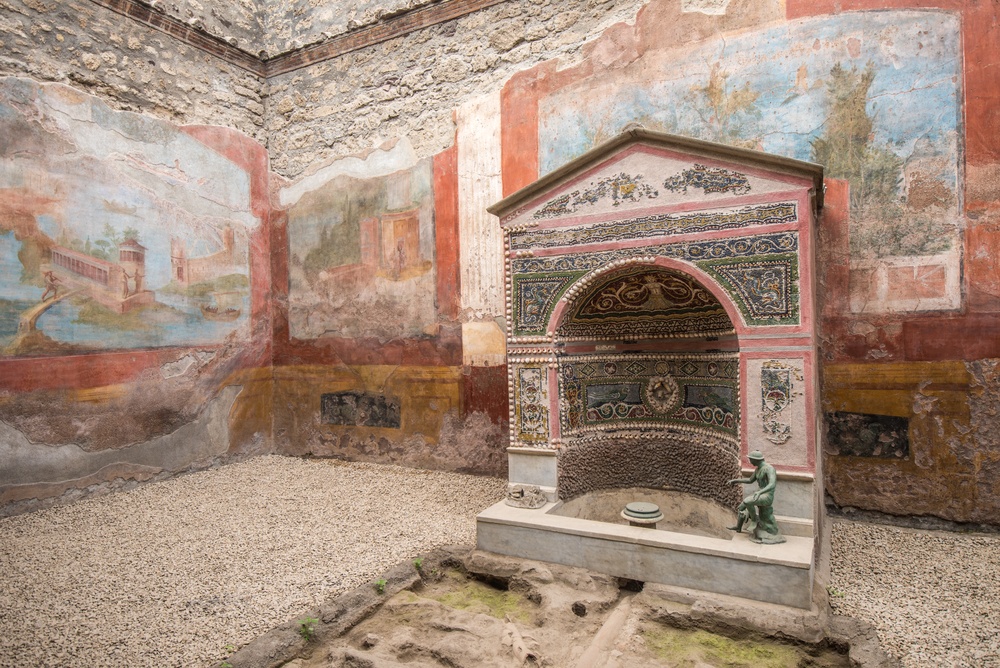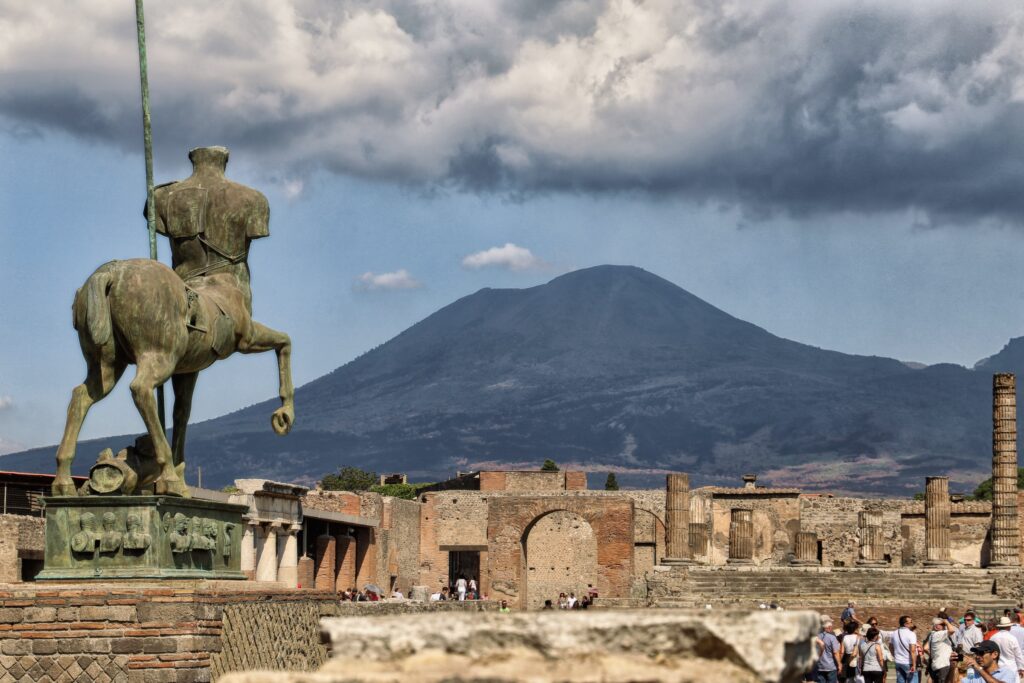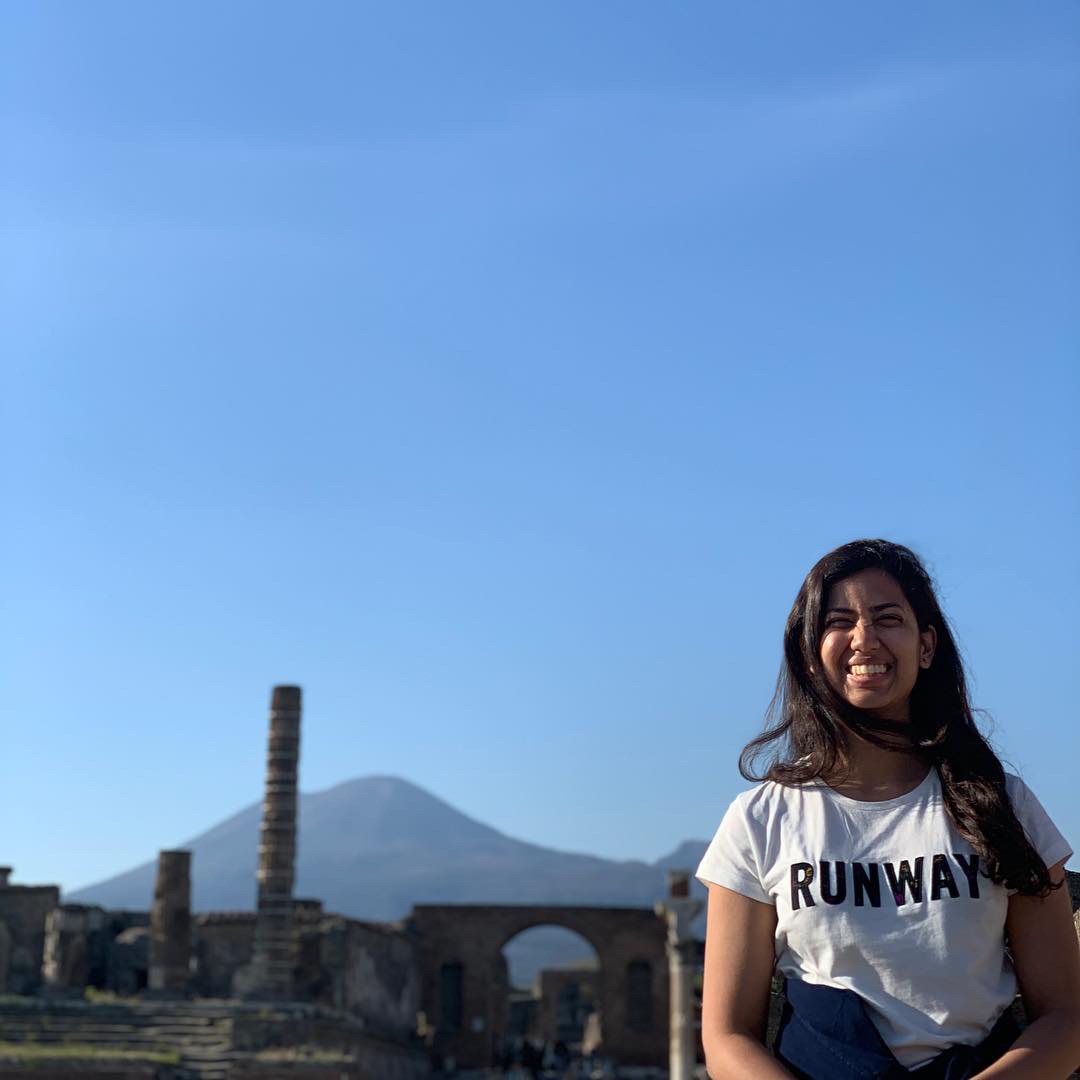On the west coast of Italy, just a little south of Rome, lies the ancient city of Pompeii foreshadowed (physically and symbolically) by the only active volcano in mainland Europe – Mount Vesuvius. This UNESCO world heritage site is well worth a day visit if you are travelling to a nearby city.
Before I start this article, I have to admit that I had not heard about Pompeii before I visited Naples. The friend I was visiting with suggested that we make a trip to this popular historic site. And my first reaction was thinking what makes it so special that people come from all over the world to see a bunch of ruins. We decided that we had to visit to find out the answer.
In terms of planning, we were already staying in Naples for 2 nights. So we just had to take a 30min train ride to Pompeii. We skipped taking a tour, and instead travelled ourselves and took a guided tour inside the site.
What is special about Pompeii?
It used to be a thriving Roman city and a popular holiday destination ages ago. It flourished very close to the volcano which was never really seen as a threat. In fact, people grew vineyards and olive groves in the fertile soils of its slopes. It also became an affluent port town with its ready access to the sea and the nearby Appian Way trade route.
Until 79 AD, when a cataclysmic eruption took place drowning the city with a flood of lava and pumice. The sudden impact buried the whole land along with its inhabitants and even animals underneath million of tonnes of volcanic ash. Not just Pompeii, but neighbouring towns like Herculaneum, and big villas also got destroyed. And then it was all forgotten until it got rediscovered in 1748.
An era of modern archaeology began when such a large city was found perfectly preserved. Large scale excavation started, and even continues till date but in a more controlled manner. This was the first case, where the world can open a direct window into the middle-class Ancient Roman Period. A time period that felt like it was carefully frozen for future generations to see.
Inside the walls

A guided tour is really helpful to delve deeper into understanding the ruins here. They further explain the finesse with which delicate pieces here are displayed today. From using different techniques like ‘encaustic’ where paint is mixed with wax, to using special chemicals to preserve the natural pigments in the painting, or to making casts of people from hollow spaces in the debris.
The site showcases amazing fresco art and eclectic architectural motifs spanning various centuries that divide Pompeii’s history up like the rings of a tree – often within the same building. Frescos used to be paintings done on walls inside private houses and have survived due to its durable nature. House of the Vetti is also a beautiful example of a villa owned by wealthy merchants and designed tastefully.
Then there is the Basilica at the end of the Forum. A forum used to be a public square meant for social gatherings, markets, and political activity. What remains now are the stone foundations and the layout to paint a picture of how this might have looked like. Another impressive construction that is still intact is the Amphitheatre. The oldest surviving Roman amphitheatre that did not get altered over time.
One can see broken columns, cracked-facades, enter inside once-lavish buildings and get an insight into how people lived at that time. And then I realised why someone (even without a particular interest in history) would make a special trip to see these ruins. I had visited Rome before and seen the Roman forum, but this place felt more grandeur and much better preserved.
Mount Vesuvius

We took out 2-3 hours from our day to visit Vesuvius as we were so close to it, and walking up a volcano was something I had never done before. Even though it is an active volcano, it has not erupted since 1944 and is safe to visit till its top. It is part of a national park and one can take a ticket to walk one of its many routes.
We walked from the entrance till the crater, and it was an easy 2-3 hours walk. It is also a delight to walk with views of the mediterranean coastline and towns below.
Vesuvius is considered as a stratovolcano, meaning it has got multiple layers of hardened lava and tephra. It also boasts a large cone which was caused by its previous eruptions.
In honest opinion, it was much like hiking any other mountain trail. The crater was impressive with small fumes visible, but otherwise it did not have anything unique.
How to reach there?
- From Naples or Sorrento, catch the Circumvesuviana train which drops right outside the Pompeii Scavia station. It only costs 3€.
- For Mount Vesuvius, there is a private bus service from this train station, or a public bus service from in front of the main gates (15mins walk).
- More details and up to date information about travel options can be found here.
Planning ahead
There are three entrances to Pompeii. Two southwest of the excavations, near the train station. The third entrance (Piazza Amfitheatro) is a 15-minute walk from the east of the modern city of Pompei itself. If you travel by train, pick on of the two entrances southwest of the excavations.
Pompeii has different opening times in different seasons. I went in march when it closed by 5pm, so we started our day early as once clearly needs a couple of hours to see this place. Some people even plan around 2-3 days to cover the whole site.
It is a big archaeological area divided into nine neighbourhoods. They are designated by roman numerals like districts V, IV and III. So it is good to plan a route, or follow a guide.
More tips
It can get very hot due to lack of shade, especially during peak summer months. I went in late March and the weather was quite sunny but still pleasant.
For planning a trip from Rome or Amalfi coast, one has to change trains. It is still possible to do it via private tours or self but keep the time crunch in mind.
If you are craving for authentic Napoli pizza after this, here are some recommendations.
Visiting historic sites was kind of thought provoking, it made me ponder over how far we have come and at the same time pondering over the similarities with generation that lived centuries ago.
For me it also turned out pretty amazing as I had never read about the place, never seen photos and didn’t know what to expect. So with every step, I found myself mesmerised by interesting details I saw and stories I heard.

